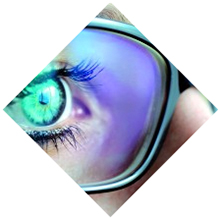
Anti-reflective coatings
Without reflections you see better
Anti-reflective coatings on spectacle lenses reduce reflections that can occur on the surface of the spectacle lens. In this case, the light is reflected in a lower intensity than that with which it hits the lens.
It reduces the external reflections that trouble spectacle wearers, as well as reflections which strike the lenses from behind. Also, people looking at the spectacle wearer are less distracted by reflections and are better able to see the eyes of the wearer.
The better the quality of an anti-reflective coating, the less troublesome the reflections are. Anti-reflective coatings are deposited on both sides of the lens, which then make possible clear, non-tiring vision with good contrast.
These days, it is possible to apply anti-reflective coatings to all lenses in a variety of strengths.
High-quality, anti-reflective coatings that reduce glare the best display a green residual reflection. New technologies make it possible to have tinted spectacle lenses with a transparent residual reflection to avoid unpleasant colour combinations.
Lenses with anti-reflective coatings are particularly desirable at night and if the roads are wet.
→ Read more about anti-reflective coatings from Hoya
→ Read more about mirror coatings
Hard sealing
Scratch prevention for plastic lenses
It is possible to protect plastic spectacle lenses from scratching in the long term by means of a hard coating. This coating is applied on both sides, using a dipping process. To do this, the lenses are inserted in a basket and then dipped in the hard lacquer. Once they have been left to harden for a specific time, the lenses are then protected against scratches. The adhesion of various anti-reflection coatings is also improved by applying a hard anti-scratch coating.

